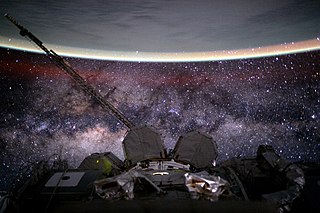
The Big Bang was the initiation of the continuing expansion of the universe from a state of high density and temperature. It was first proposed as a physical theory in 1931 by Roman Catholic priest and physicist Georges Lemaître when he suggested the universe emerged from a "primeval atom". Various cosmological models of the Big Bang explain the evolution of the observable universe from the earliest known periods through its subsequent large-scale form. These models offer a comprehensive explanation for a broad range of observed phenomena, including the abundance of light elements, the cosmic microwave background (CMB) radiation, and large-scale structure. The overall uniformity of the universe, known as the flatness problem, is explained through cosmic inflation: a sudden and very rapid expansion of space during the earliest moments. However, physics currently lacks a widely accepted theory of quantum gravity that can successfully model the earliest conditions of the Big Bang.

Physical cosmology is a branch of cosmology concerned with the study of cosmological models. A cosmological model, or simply cosmology, provides a description of the largest-scale structures and dynamics of the universe and allows study of fundamental questions about its origin, structure, evolution, and ultimate fate. Cosmology as a science originated with the Copernican principle, which implies that celestial bodies obey identical physical laws to those on Earth, and Newtonian mechanics, which first allowed those physical laws to be understood.
In astronomy, dark matter is a hypothetical form of matter that appears not to interact with light or the electromagnetic field. Dark matter is implied by gravitational effects which cannot be explained by general relativity unless more matter is present than can be seen. Such effects occur in the context of formation and evolution of galaxies, gravitational lensing, the observable universe's current structure, mass position in galactic collisions, the motion of galaxies within galaxy clusters, and cosmic microwave background anisotropies.
The Torino scale is a method for categorizing the impact hazard associated with near-Earth objects (NEOs) such as asteroids and comets. It is intended as a communication tool for astronomers and the public to assess the seriousness of collision predictions, by combining probability statistics and known kinetic damage potentials into a single threat value. The Palermo Technical Impact Hazard Scale is a similar, but more complex scale.

Astronomy is a natural science that studies celestial objects and the phenomena that occur in the cosmos. It uses mathematics, physics, and chemistry in order to explain their origin and their overall evolution. Objects of interest include planets, moons, stars, nebulae, galaxies, meteoroids, asteroids, and comets. Relevant phenomena include supernova explosions, gamma ray bursts, quasars, blazars, pulsars, and cosmic microwave background radiation. More generally, astronomy studies everything that originates beyond Earth's atmosphere. Cosmology is a branch of astronomy that studies the universe as a whole.

A galaxy cluster, or a cluster of galaxies, is a structure that consists of anywhere from hundreds to thousands of galaxies that are bound together by gravity, with typical masses ranging from 1014 to 1015 solar masses. They are the second-largest known gravitationally bound structures in the universe after some superclusters (of which only one, the Shapley Supercluster, is known to be bound). They were believed to be the largest known structures in the universe until the 1980s, when superclusters were discovered. One of the key features of clusters is the intracluster medium (ICM). The ICM consists of heated gas between the galaxies and has a peak temperature between 2–15 keV that is dependent on the total mass of the cluster. Galaxy clusters should not be confused with galactic clusters (also known as open clusters), which are star clusters within galaxies, or with globular clusters, which typically orbit galaxies. Small aggregates of galaxies are referred to as galaxy groups rather than clusters of galaxies. The galaxy groups and clusters can themselves cluster together to form superclusters.

Outer space is the expanse beyond celestial bodies and their atmospheres. It contains ultra-low levels of particle densities, constituting a near-perfect vacuum of predominantly hydrogen and helium plasma, permeated by electromagnetic radiation, cosmic rays, neutrinos, magnetic fields and dust. The baseline temperature of outer space, as set by the background radiation from the Big Bang, is 2.7 kelvins.

The observable universe is a ball-shaped region of the universe consisting of all matter that can be observed from Earth or its space-based telescopes and exploratory probes at the present time; the electromagnetic radiation from these objects has had time to reach the Solar System and Earth since the beginning of the cosmological expansion. Initially, it was estimated that there may be 2 trillion galaxies in the observable universe. That number was reduced in 2021 to only several hundred billion based on data from New Horizons. Assuming the universe is isotropic, the distance to the edge of the observable universe is roughly the same in every direction. That is, the observable universe is a spherical region centered on the observer. Every location in the universe has its own observable universe, which may or may not overlap with the one centered on Earth.
Quantum foam or spacetime foam is a theoretical quantum fluctuation of spacetime on very small scales due to quantum mechanics. The theory predicts that at these small scales, particles of matter and antimatter are constantly created and destroyed. These subatomic objects are called virtual particles. The idea was devised by John Wheeler in 1955.

The James Webb Space Telescope (JWST) is a space telescope designed to conduct infrared astronomy. Its high-resolution and high-sensitivity instruments allow it to view objects too old, distant, or faint for the Hubble Space Telescope. This enables investigations across many fields of astronomy and cosmology, such as observation of the first stars and the formation of the first galaxies, and detailed atmospheric characterization of potentially habitable exoplanets.
Newgrounds is a company and entertainment website founded by Tom Fulp in 1995. It hosts user-generated content such as games, films, audio, and artwork. Fulp produces in-house content at the headquarters and offices in Glenside, Pennsylvania.

Planck was a space observatory operated by the European Space Agency (ESA) from 2009 to 2013. It was an ambitious project that aimed to map the anisotropies of the cosmic microwave background (CMB) at microwave and infrared frequencies, with high sensitivity and angular resolution. The mission was highly successful and substantially improved upon observations made by the NASA Wilkinson Microwave Anisotropy Probe (WMAP).
The expansion of the universe is the increase in distance between gravitationally unbound parts of the observable universe with time. It is an intrinsic expansion, so it does not mean that the universe expands "into" anything or that space exists "outside" it. To any observer in the universe, it appears that all but the nearest galaxies recede at speeds that are proportional to their distance from the observer, on average. While objects cannot move faster than light, this limitation applies only with respect to local reference frames and does not limit the recession rates of cosmologically distant objects.
The chronology of the universe describes the history and future of the universe according to Big Bang cosmology.

El Gordo is the largest distant galaxy cluster observed at its distance or beyond, as of 2011. As of 2014, it held the record for being the largest distant galaxy cluster to have been discovered with a mass of slightly less than three quadrillion solar masses although later its mass was reduced to about 2.1 quadrillion solar masses with a 10% uncertainty. It was found by NASA's Chandra X-ray Observatory, the Atacama Cosmology Telescope and the European Southern Observatory's Very Large Telescope.
SYBO Games is a Danish video game company located in Copenhagen, Denmark founded by Sylvester Rishøj Jensen and Bodie Jahn-Mulliner. SYBO is mainly known for being the creators and intellectual property owners of the second-most-downloaded mobile-runner game, Subway Surfers, which SYBO co-developed with Kiloo. SYBO has also released a second mobile runner game titled Blades of Brim. Like Subway Surfers, Blades of Brim is also an endless runner freemium title with in-app purchases. SYBO was among the first seven Snapchat games with Subway Surfers Airtime, released late 2019.

Kurzgesagt is a German animation and design studio founded by Philipp Dettmer. The studio is best known for its YouTube channel, which focuses on minimalistic animated educational content using flat and 3D design style. It discusses scientific, technological, political, philosophical, and psychological subjects.

Fluent Design System, officially unveiled as Microsoft Fluent Design System, is a design language developed in 2017 by Microsoft. Fluent Design is a revamp of Microsoft Design Language that includes guidelines for the designs and interactions used within software designed for all Windows 10 and Windows 11 devices and platforms. The system is based on five key components: light, depth, motion, material, and scale. The new design language includes more prominent use of motion, depth, and translucency effects.

Verge3D is a real-time renderer and a toolkit used for creating interactive 3D experiences running on websites.

Ruffle is a free and open source emulator for playing Adobe Flash (SWF) animation files.












